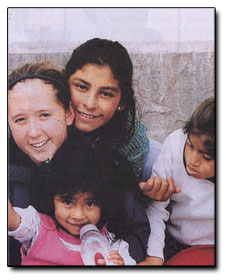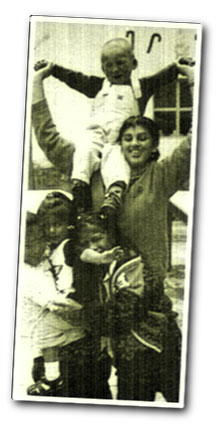

But all the changed when the Rotary Club of Centerville, the Interact club's sponsor, to Hogar San Francisco de Asis, an orphanage for underprivileged children in Cuzco , Peru . When the club sent a team of professionals to Cuzco to inspect the orphanage and assess its needs, a group of Interactors went along as goodwill ambassadors to the children.
 In selecting the students for the trip, the Rotary Club asked the Interactors to write essays explaining why they wanted to go and what they hoped to achieve. Six Interactors were chosen to make the trip during their 2003 spring break, 29 March-6 April: Candida Crasto, Lindsey Eggers, Brittany Lynn Mink, Cristina Romeo, Angela Schedler, and Paul Woo.
In selecting the students for the trip, the Rotary Club asked the Interactors to write essays explaining why they wanted to go and what they hoped to achieve. Six Interactors were chosen to make the trip during their 2003 spring break, 29 March-6 April: Candida Crasto, Lindsey Eggers, Brittany Lynn Mink, Cristina Romeo, Angela Schedler, and Paul Woo. 'We built this around the Interactors," says Debra Kremer, the Rotary club's Interact liaison. "Center is a well-to-do community. Our Interactors had done fundraising but they hadn't had hands-on experience. We wanted them to do some hands-on work."
The Rotary club and District 6670 provided about $8,000 to help pay the Interactors' way. The Interact club sold candy to raise another $1,200.
Kremer traveled with the Interactors, as did Rotarians Fred Weir, who works in constraction, and Jack Workman, a veterinarian. The team also included Centerville residents Joyce Ahmad, a teacher who had alerted the club to the orphanage and served as the group's liaison; Charles Cox, a dentist; and Andrew Humphries, an engineer and the husband of Rotarian Cindy Klinck.
Located in the valley in the southeastern Andres, Cuzco (population 300,000) is one of the oldest cities in South America . Once the capital of the Inca empire, Cuzco has become a tourist destination because of its wealth of historical, architectural, and archaeological sites. But its cultural wealth is offset by serious poverty. Hogar San Francisco de Asis opened its doors to needy children of Cuzco and the surrounding area in 1984, originally housing five deaf orphans in a small, run-down home. The current quarters are home to 85 children, of whom 68 are deaf and five are mentally disable.
"It took many years just to have a nice house where the kids can be comfortable," says Sister Consuelo, the nun who has manage the orphanage since 1999. "We cannot [take in] any more children because the house is small and the food costs too much."
Knowing that Hogar San Francisco de Asis needed help, the Interactors approached their mission with enthusiasm and a sense of purpose but weren't quite sure what to expect. What would the conditions be like? What sort of work would be required/ would the children accept them?
"I expected the trip to be like a work camp," Crasto says. "But this time you were working with people, rather than building things."
Mink, who describes the journey as a "dream come true," was determined to make the exploratory mission a success.
"I was nervous about the trip since it was a pilot trip," she says. "I wanted to make a difference and touch each child I met in hopes of making them happier."
 As the Interactors learned shortly after their arrival in Cuzco , finding ways to connect with each child would not present much of challenge.
As the Interactors learned shortly after their arrival in Cuzco , finding ways to connect with each child would not present much of challenge. "They all at once were giving us hugs, holding our hands, kissing our hands, touching our faces, signing various phrases to us, and just trying to capture and hold our attention," Crast says.
The adults went to work surveying the needs of the orphanage and making repairs where they could. Kremer, who lugged a sewing machine in her suitcase, mended the children clothing. Cox administered badly needed dental care and made arrangements for local dentists to continue treating the children. Weir, Workman, and Humphries examined the facilities of the orphanage and at a nearby farm owned by the orphanage. They determined that a major $400,000 renovation was needed.
"All of us were naïve to what life is like in a country like that," Kremer says, adding that it was especially eye opening for the Interactors. "Now they talk about how much they appreciate what they have, after seeing how deprived those kids are."
From the moment they arrived, the Interactors focused on getting to know the children. The high schoolers spent four days sitting in on classes, teaching the youngster games and dances, and generally engaging them as much as time would allow. The Interactors where impressed by the way the children made the best of their situation.
"It was interesting how, no matter what, each child would help another child," Romeo Says. "If one child had a hard time walking, the others would take him by the hand. They all worked together. It was a beautiful thing to see."
At school and at play, the children of the orphanage demonstrated creativity and a thirst for knowledge. As soon as the Interactors arrived, the children began to give them names in sign language.
"They had never seen an Asian person before," says Woo, who is Korean American. "When they saw me, they took one finger for each hand and made the distinct Asian eyes, which became my name in sign language."
The children where fascinated by Woo that they would try to touch his face while he slept, an experience he found startling but amusing, and he was more than happy to indulge their curiosity.
"They may need material things, but what they need most is love." Woo says. "There are 85 kids and four adults, so not many kids are getting attention and love every day."
The Rotarians hope was that a trip to Cuzco would instill in the Interactors a strong sense of their roles in society and the importance of service. Schedler says it definitely had an effort on her.
"I take nothing I have in life for granted, whether it's having clothes, food or a house to live in," says Schedler, who is already making plans to go abroad to do more service work with a friend. She hopes to become a Peace Corps volunteer after high school.
Weir says the trip was a success. The Centerville Rotary club is exploring ways to raise money for the work needed for the orphanage, and another group will travel to Cuzco next year, Including members of the Interactors club.
Kremer knows that the Interactors from this year will spread enthusiasm for next year's trip among their pears.
"The kids just had a wonderful, heartfelt relationship with the children," Kremer says. "All they could talk about the whole way home was that they left too early, that they couldn't do enough.
Anthony G. Craine is senior editor of THE ROTARIAN.